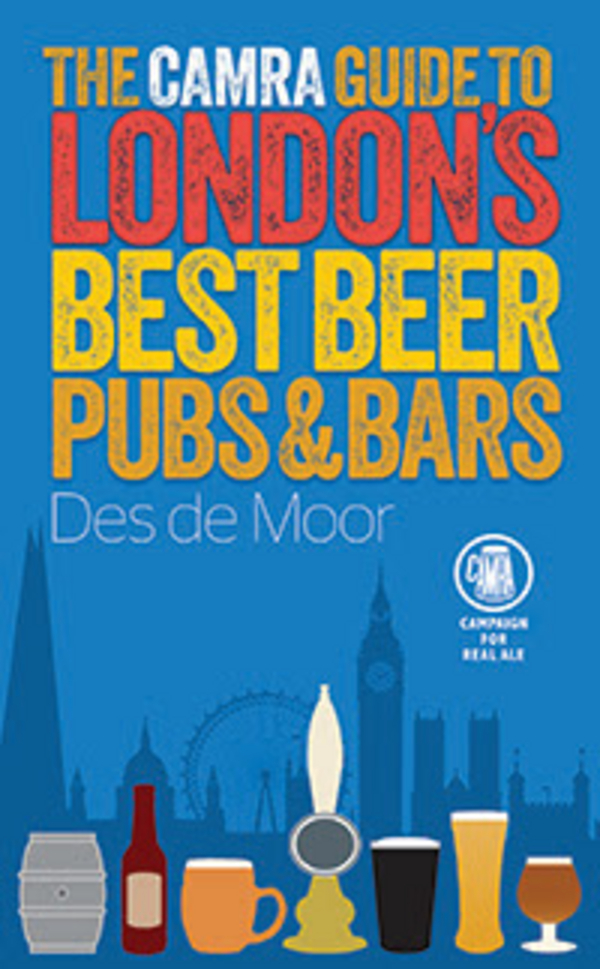Raising a glass to London's beer boom
Added: Wednesday, July 15th 2015

The CAMRA Guide to London’s Best Beer, Pubs & Bars: Des de Moor, £12.99
The first beer I can recall drinking was Charrington’s IPA in a pub close to Upton Park station in East London. Memory can play tricks but, brewed then in the Mile End Road, I remember a pale and gloriously hoppy beer.
Close by, a large hoarding next to West Ham United’s ground, told me there were more hops in Ben Truman, emphasised by a cartoon version of Long John Silver on his peg leg. I was intrigued and at the start of a steep learning curve.
When I went to work in the heart of the newspaper industry in Fleet Street, just down from St Paul’s Cathedral, I discovered not only amazing pubs such as the Punch Tavern and the Olde Cheshire Cheese but many more London brewers dispensing liquid joy: Courage, Manns, Truman, Watneys and Whitbread. When I had my first taste of Young’s Bitter from Wandsworth I thought I’d been given the keys to paradise.
One by one, all those breweries disappeared, some as a result of a spate of manic mergers and takeovers, with property companies desperate to buy pubs and to hell with the breweries. When CAMRA, the Campaign for Real Ale, was formed in 1971 it dubbed London – once the greatest brewing city in the world – a “beer desert” as a result of the poor choice then available.
The great beer revival of recent years seemed to bypass the capital. The number of new breweries in the rest of the country grew at a furious pace but London seemed impervious to change and went into reverse with the closure of Young’s in 2006.
In fact, the closure of Young’s seemed to act as a catalyst. So distraught was Duncan Sambrook at the loss of his local brewery that he and friends raised the money to open a new brewery close to Wandsworth in Battersea. A handful of others followed his example.
By the time Des de Moor wrote the first edition of his CAMRA Guide to London’s Best Beer, Pubs & Bars in 2011, there were 14 breweries in London. He has just published a new edition of the book and his incredulity at the changes he has encountered is evident from the very first page. In 2011, he says, “there was already a buzz of excitement in the air, but nobody could have predicted quite how far things would go. This book details 70 London breweries and counting. It’s an astonishing story.”
An astonishing story and one he tells well. This is a superb book, beautifully designed with full colour images of pubs and breweries. For readers unfamiliar with London’s brewing history, he recounts the rise of the great breweries that dominated the capital from the 18th to the 20th centuries and gave the world the first porters, stouts, milds and India Pale Ales – the last-named better known for its Burton heritage but originally brewed in the capital.
London pottered along for most of the 20th century with just two main beer styles, mild and bitter. But, as de Moor shows, a new generation of young and innovative brewers are kicking over the traces and brewing just about every beer style known to personkind and inventing a few new ones of their own.
Today you will find blisteringly hoppy interpretations of American pale ales and IPAs, beers made with the addition of fruit, herbs, spices, coffee and even chillis, oak-aged beers, Belgian saisons, Bavarian wheat beers and – the buzz beer of the moment – “sours” made in the Belgian “lambic” tradition of allowing wild yeasts in the air to carry out fermentation.
Pubs and breweries are changing, too, in tune with the London beer revolution. Breweries are no longer remote and closed-off affairs but are open to the public. Drinkers can drop in, buy beer, talk to the brewers and even, in some cases, try their hands at making beer themselves.
As the images in the book show, brewers are no longer portly gents with moustaches and waistcoats but young hipsters who, if they are of the male persuasion, sport fashionably long beards and the type of wonky woolly headwear made popular by David Beckham.
Des de Moor selects 260 pubs in all parts of London and his choice stresses just how much the capital’s pub scene is changing to meet the demands of modern drinkers. He has chosen some marvellous traditional boozers but they are joined by modern bars, open-plan, plain-windowed, designed for vertical drinking, with bars groaning with handpumps and keg founts.
In keeping with CAMRA’s carefully refashioned stance, de Moor does not dismiss modern keg beers out of hand but reports on such breweries as Beavertown, Camden Town and Meantime that have developed keg beers a million miles removed from the horrors of Watneys Red of yesteryear.
The book is a joy to read and will be my constant companion on visits to the capital. And if one of the new brewers in London could bring back Charrington’s IPA he or she would make a Cockney-in-exile a very happy geezer.
*Print version: Publican’s Morning Advertiser, 15 July 2015








